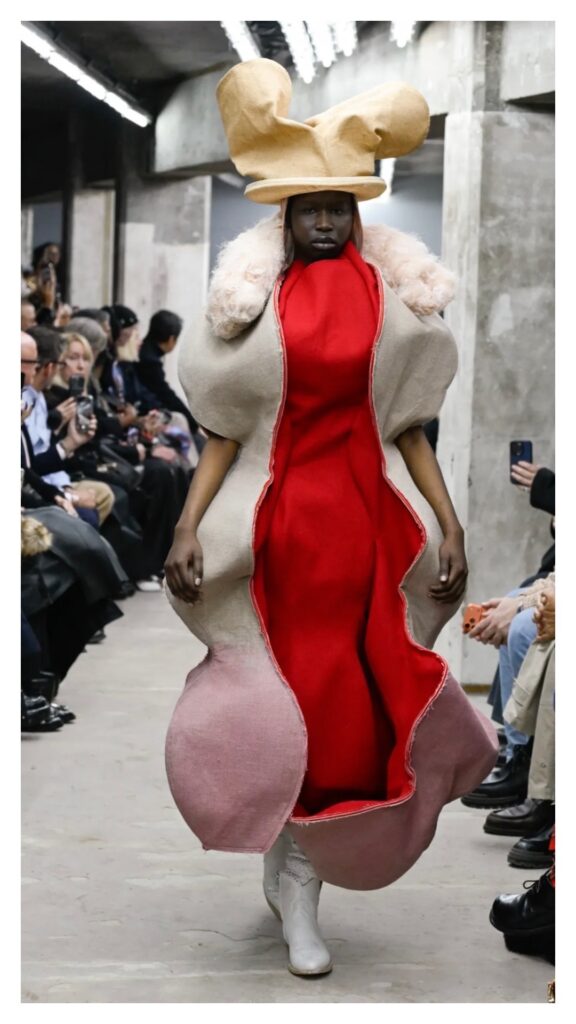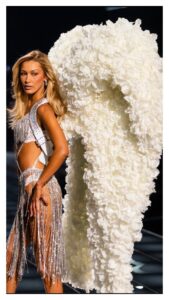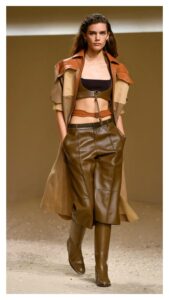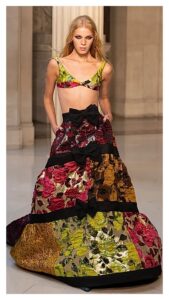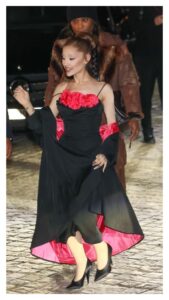The second look, a lumpy red garment encased in a delicate pink lattice, appeared to be straining against its own constraints, representing a struggle that resonated throughout the collection. This notion of deconstruction was further amplified with a striking piece made from coarse canvas, layered in ruffled textures with raw edges. As the fabric cascaded down the body, its compacted form echoed the complexities of human experience—beauty born from chaos.
Kawakubo’s exploration did not stop there. She juxtaposed deconstructed swaths of white brocade, lace, and jacquard against landscapes of canvas and jute, inviting viewers to reconsider the role of fabric in high fashion. The models, adorned with horsehair wigs that resembled unconventional upholstery, made their way down the runway, evoking the spirit of Tracey Emin’s installation, My Bed, as they donned padded sheets and pillow-like structures, hinting at a disarray that was both meaningful and intentional.
For nearly 15 minutes, the audience was enveloped in silence, save for the ambient sounds of coughing, camera shutters, and the rustling of burlap hats brushing against the venue’s concrete beams. The anticipation built until the lights dimmed, and the applause erupted—a testament to the emotional resonance of the show.
The use of humble fabrics was a recurring theme this European season, with many designers opting for cotton and linen to create grand silhouettes. However, Kawakubo took this concept to unprecedented heights, transforming burlap and calico into whimsical puffball shapes, stacked like scoops of ice cream, and occasionally topped with cone-shaped hats. Her designs elevated the mundane into breathtaking creations, encapsulating a make-do-and-mend ethos that resonated deeply with attendees.
In a follow-up statement, Kawakubo once again reiterated her belief in the beauty that can emerge from imperfection, titling her collection “After the Dust.” This phrase conjured images of resilient women emerging from the rubble of an apocalyptic landscape, adorned in dented straw hats and vibrant candy-floss hair. Were they survivors of a forgotten world, or perhaps refugees escaping persecution in an unforgiving climate? The ambiguity of her vision left much to interpretation.
The models, some adorned with whimsical bundles of detritus—paper napkins, bubble wrap, and fabric scraps—exuded an unexpected beauty that defied traditional standards. Kawakubo’s unique ability to derive elegance from unconventional materials and abstract forms was on full display, with designs featuring dangling appendages reminiscent of starfish and stacked cushions, creating a visual feast for spectators.
Despite the seriousness often associated with high fashion, moments of levity emerged during the show. Laughter erupted from the audience as models navigated the narrow, low-ceilinged runway, their towering straw hats forcing them to duck at awkward angles to avoid the concrete joists and fluorescent lights. This lightheartedness contrasted sharply with the fashion world’s typical gravitas, showcasing Kawakubo’s capacity to infuse humor into her artistry.
While the Paris fashion season boasted many high-profile debuts from established houses, the unwavering creativity of the Japanese design contingent, led by Kawakubo, captured the attention of industry insiders. The Comme des Garçons show served as a poignant reminder that innovation and artistry thrive in the realm of the unconventional.
The collection’s radical approach challenged the audience to rethink their perceptions of beauty and fashion. In an era where perfection is often idolized, Kawakubo’s work advocates for the acceptance of flaws and the power of transformation. The runway became a stage for exploration, inviting viewers to embrace the beauty of the imperfect and the extraordinary.
As the evening concluded, attendees left with a renewed sense of inspiration and a deeper understanding of Kawakubo’s artistic vision. Her ability to weave narratives through fabric, coupled with her commitment to challenging the status quo, solidifies her legacy as one of fashion’s most influential figures. In a world increasingly obsessed with perfection, the Comme des Garçons Spring/Summer 2026 collection stands as a testament to the beauty that arises from imperfection and the creative spirit that thrives in the face of adversity.
